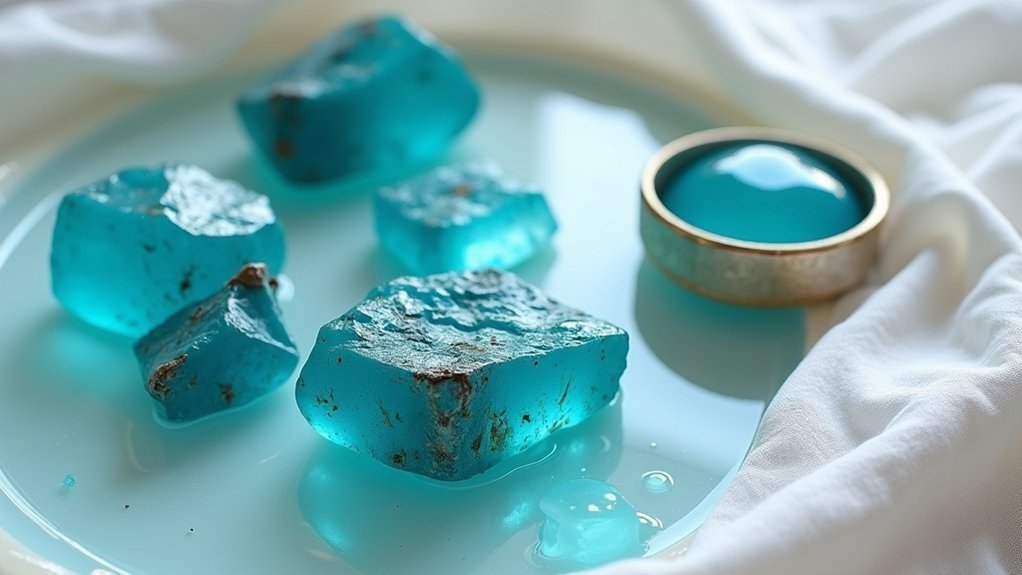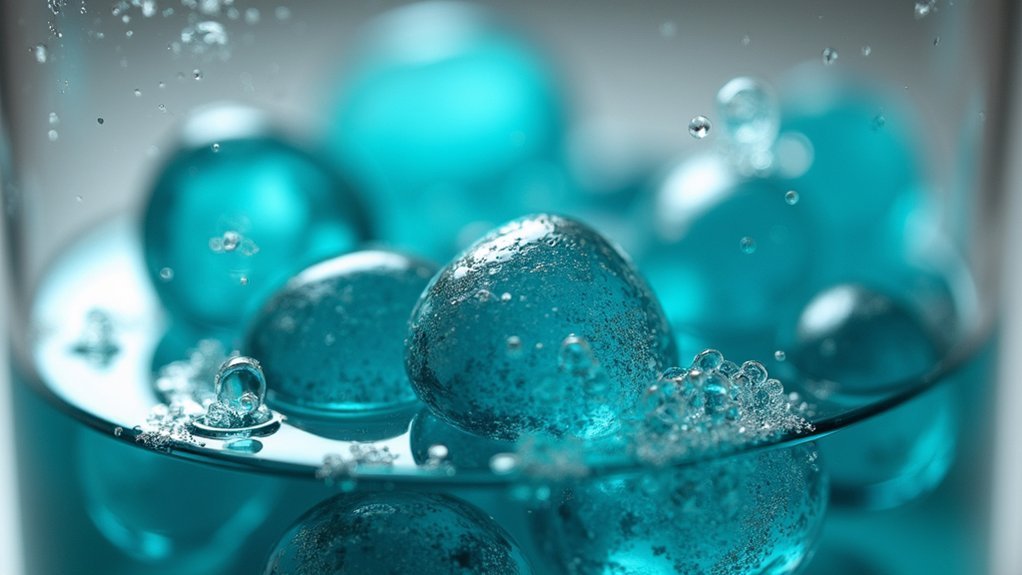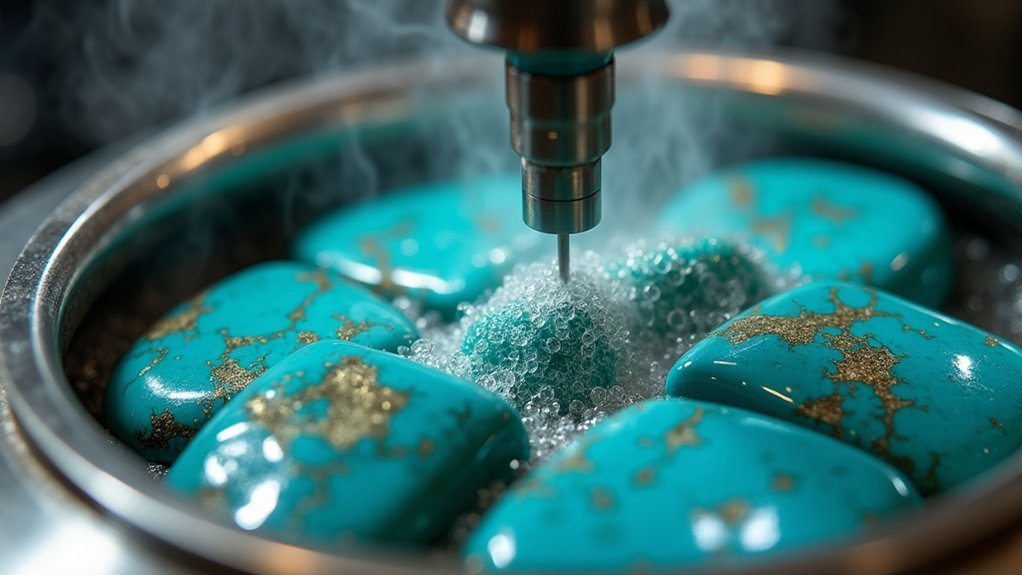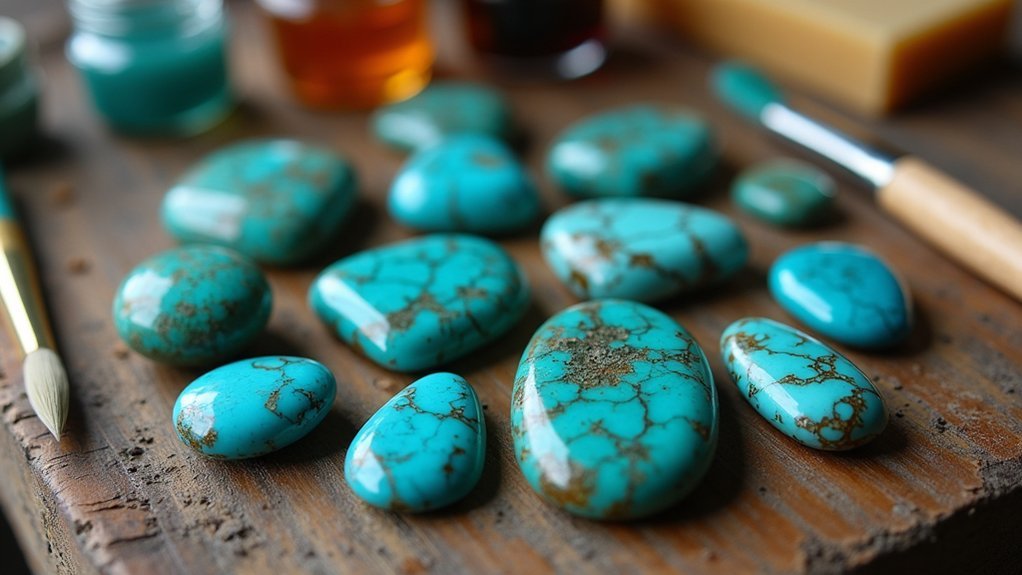You can stabilize turquoise for jewelry making using five effective methods: acetone and two-part epoxy soaking, vacuum impregnation with resin under pressure, sodium silicate solution treatment, mineral oil immersion, and high-pressure injection with heated vacuum chambers. Each technique penetrates the stone’s porous structure differently, transforming fragile turquoise into durable gemstone material. These methods improve hardness, enhance color saturation, and prevent deterioration. The specific approach you’ll choose depends on your equipment availability and desired results for your jewelry applications.
Acetone and Two-Part Epoxy Soaking Method

While turquoise’s natural beauty makes it highly sought after for jewelry, its porous nature often requires stabilization to achieve the durability needed for crafting. The acetone and two-part epoxy soaking method effectively penetrates and strengthens these natural stones over 4-5 days.
To stabilize turquoise using this technique, you’ll mix one pint of acetone with Devcon 5-minute clear epoxy in a quart glass jar. Stir until the two-part epoxy dissolves completely.
Submerge your turquoise pieces in this solution, checking daily for cloudiness or waxy appearance that signals removal time.
After soaking, allow items to drip dry thoroughly. The stabilization process requires up to one week for complete curing as acetone evaporates, leaving behind strengthened turquoise perfect for jewelry making.
Vacuum Impregnation With Resin Under Pressure
For particularly soft or heavily fractured turquoise, vacuum impregnation with resin under pressure delivers superior stabilization results compared to simple soaking methods.
This technique guarantees thorough penetration into the stone’s porous structure, making it ideal for jewelry applications.
The process involves placing your turquoise in a specialized vacuum chamber where air gets removed, allowing resin to penetrate deeper into cracks and voids.
Vacuum chambers eliminate air pockets, enabling resin to flow deeply into every fracture and porous area of the turquoise stone.
Here’s what you’ll need:
- Specialized vacuum pump and chamber system
- High-quality stabilizing resin suitable for stones
- Heat source to enhance resin flow
- Pressure application equipment
- Curing setup for solidifying the material
After impregnation, you’ll cure the resin through controlled heating, which solidifies the material and dramatically increases durability.
This method particularly excels at transforming soft turquoise varieties into stable, workable stones perfect for jewelry making without compromising natural beauty.
Sodium Silicate Solution Treatment Process

Another effective approach uses sodium silicate solution to stabilize turquoise through a slower but highly reliable chemical process.
You’ll soak your turquoise in the sodium silicate solution for several days, allowing it to penetrate deeply and fill cracks or voids throughout the stone. After soaking, you’ll heat the treated turquoise at low temperatures to cure the solution, greatly improving hardness and durability.
This method works exceptionally well for stabilizing turquoise that’s soft and porous, preventing it from damage and ensuring it won’t change color over time.
The sodium silicate solution will enhance color saturation while stopping further deterioration. However, you’ll find achieving complete saturation challenging in stones with substantial matrix, as the solution may not penetrate these areas uniformly.
Mineral Oil Immersion Stabilization Technique
When working with particularly porous turquoise specimens, you’ll find mineral oil immersion offers a gentler alternative to chemical stabilization methods. This technique involves submerging your stones in mineral oil for approximately one month, allowing complete penetration into voids and cracks.
The process enhances durability while preserving the stone’s natural characteristics:
Mineral oil immersion strengthens turquoise without compromising its authentic beauty and natural stone properties.
- Clean turquoise thoroughly before immersion to maximize oil absorption
- Submerge porous turquoise completely in mineral oil for 30 days
- Monitor softer varieties, as they absorb oil more effectively than harder stones
- Remove excess oil carefully after the immersion period ends
- Polish the stabilized turquoise to achieve desired shine and finish
This method creates a protective barrier that prevents cracking and color fading, making your stones ideal for jewelry applications while maintaining their authentic appearance.
High-Pressure Injection With Heated Vacuum Chambers

While mineral oil immersion works well for basic stabilization, high-pressure injection with heated vacuum chambers delivers superior results for challenging turquoise specimens.
You’ll place your premium turquoise in a vacuum chamber where air’s removed, creating pressure differentials that drive stabilizing resin deeper into porous structures.
The process involves heating resin to reduce viscosity, enabling better penetration into stone voids. You’ll then apply high pressure to force resin throughout the material’s interior spaces.
This technique greatly improves hardness and provides enhanced durability that’s perfect for high-traffic jewelry pieces.
However, you’ll need costly specialized equipment and must understand both stabilization processes and turquoise material properties.
When executed properly, this method transforms fragile specimens into durable gemstones suitable for demanding jewelry applications.
Frequently Asked Questions
How to Stabilize Turquoise?
You’ll soak your turquoise stones in a two-part epoxy and acetone mixture for 4-5 days in a well-ventilated area. Check daily, then let them drip dry completely before the epoxy hardens.
What Will the Proper Stabilization of a Turquoise Stone Do?
You’ll enhance turquoise’s durability by preventing cracking and crumbling. The process increases hardness, improves color retention, creates uniform appearance, and makes your stone more resilient to wear and environmental damage.
How to Protect Turquoise Jewelry?
You’ll protect turquoise jewelry by avoiding harsh chemicals and storing pieces separately. Clean with soft, damp cloths, apply thin wax layers, and don’t wear during sports or rigorous activities.
Does Sleeping Beauty Turquoise Need to Be Stabilized?
You don’t always need to stabilize Sleeping Beauty turquoise since it’s naturally hard and dense. However, you should consider stabilization if your stone has visible cracks or you’re making high-wear jewelry pieces.
In Summary
You’ve now got five proven methods to stabilize your turquoise effectively. Whether you’re using epoxy soaking, vacuum impregnation, sodium silicate treatment, mineral oil immersion, or high-pressure injection techniques, each approach will strengthen your stones for jewelry making. Choose the method that best fits your equipment and skill level. With proper stabilization, you’ll transform fragile turquoise into durable gemstones that’ll last for years in your finished jewelry pieces.





Leave a Reply